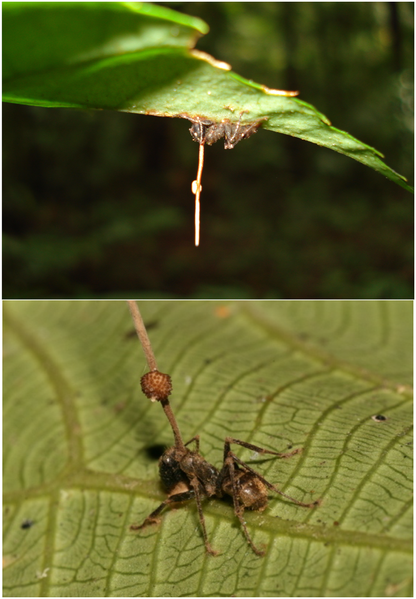Zombie Ants – Strange World of Parasites
Ophiocordyceps unilateralis is a parasitoidal fungus that infects ants such as Camponotus leonardi, and alters their behavior in order to ensure the widespread distribution of its spores. This is a prime example of such a parasitoid.
Morphology
The species can be identified at the end of its lifecycle by its reproductive structure, consisting of a wiry yet pliant darkly pigmented stroma stalk extending from the back of the deceased ant’s head. The stalk has perithecia just below its tip.

Life cycle
Like other fungi pathogenic to insects in the Ophiocordyceps genus, O. unilateralis targets a specific host species; which is ideally the Camponotus leonardi ant, but has been known to parasitize other closely related species of ants with lesser degrees of host manipulation and reproductive success.
The fungus’s spores enter the body of the insect likely through the cuticle by enzymatic activity, where they begin to consume the non-vital soft tissues. Yeast stages of the fungus spread in the ant’s body and presumably produce compounds that affect the ant’s brain and change its behaviour by unknown mechanisms, causing the insect to climb up the stem of a plant and use its mandibles to secure itself to the plant. Infected ants bite the leaf veins with abnormal force, leaving telltale dumbbell-shaped marks. A search through plant fossil databases revealed similar marks on a fossil leaf from the Messel pit which is 48 million years old.
The fungus then kills the ant, and continues to grow as its mycelia invade more soft tissues and structurally fortify the ant’s exoskeleton. More mycelia then sprout out of the ant, and securely anchor it to the plant substrate while secreting antimicrobials to ward off competition. When the fungus is ready to reproduce, its fruiting bodies grow from the ant’s head and rupture, releasing the spores. This process takes 4 to 10 days.
The changes in the behavior of the infected ants are very specific, giving rise to the term zombie ants, and tuned for the benefit of the fungus. The ants generally clamp to a leaf’s vein about 25 cm above the ground, on the northern side of the plant, in an environment with 94-95% humidity and temperatures between 20 and 30 °C. According to David Hughes, “You can find whole graveyards with 20 or 30 ants in a square metre. Each time, they are on leaves that are a particular height off the ground and they have bitten into the main vein of a leaf before dying”. When the dead ants are repositioned in various other situations, further vegetative growth and sporulation either fails to occur or results in undersized and abnormal reproductive structures.
See also: